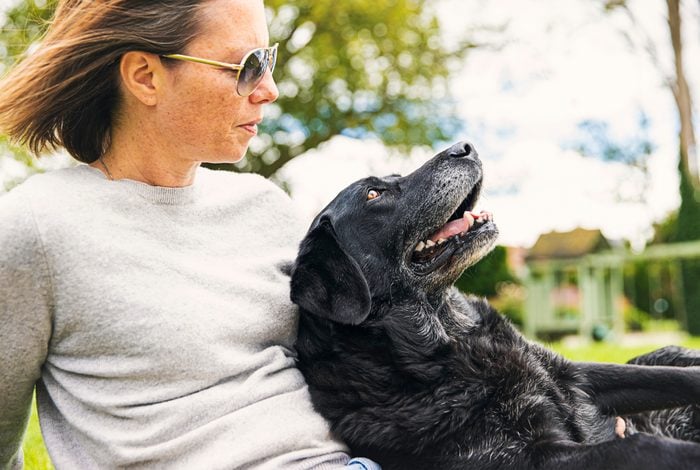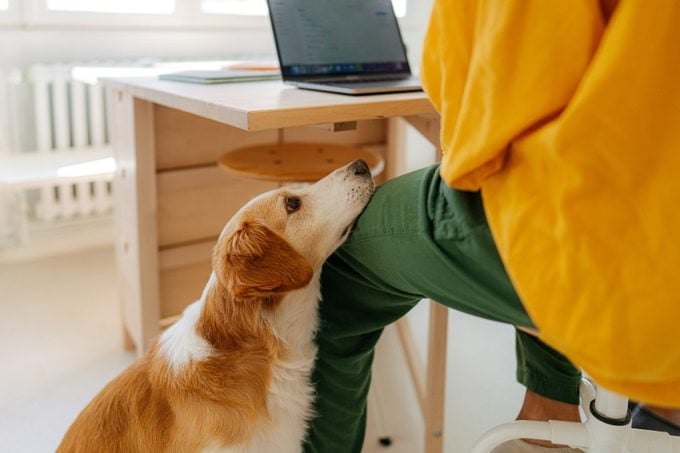Why Do Dogs Lean on You?
Updated: Apr. 09, 2024

Our dogs lean on us to express themselves, but what exactly are they trying to say? Here, top canine experts explain the reasons our pets lean against us.
Dogs love to stick close to us, following us everywhere and getting comfortable on our laps while cuddling on the couch. It’s also not unheard of for our furry friends to lean against us when we’re near, though this behavior is a little trickier to interpret. In over 13 years as a certified professional dog trainer, I’ve had plenty of dogs lean against me or sit on my feet. And just as many clients have asked, “Why does my dog lean on me?”
If you find yourself confused by dog behaviors like this, you aren’t alone. It can be tricky to understand our four-legged friends because they have their own canine culture and language. When your dog howls, paws at you or showers you with slobbery kisses, it’s trying to tell you something. The same is true when your dog leans on you.
So what should a good pet parent know about this behavior? To get the best possible advice, I turned to a trio of experts—certified canine behaviorists and dog trainers—who are well-versed in the topic. Read on to learn why your dog leans on you and to dig deeper into when this common dog behavior signals a problem.
Get Reader’s Digest’s Read Up newsletter for more pet insights, humor, travel, tech and fun facts all week long.
About the experts
Reviewed for accuracy by: Wailani Sung, DVM, a vet with a board certification in veterinary behavioral medicine who owns Bay Area Vet Behavior. Dr. Sung is the co-author of From Fearful to Fear Free: A Positive Program to Free Your Dog from Anxiety, Fears and Phobias. |
Why does my dog lean on me?
One trick for understanding how dogs use touch to communicate is to consider the human equivalent. “The common element between most instances of dogs making physical contact with us is because it feels safe,” says certified behavior consultant and dog trainer Devan Amundsen, CBCC-KA, CPDT-KA. “I think I’d describe it like holding hands with someone. Sometimes it’s because you’re nervous, other times because you’re content and other times because there’s a lot going on and I want to watch [where I’m walking] without losing track of you.”
With the help of the experts, we’ll explore the most common answers to the question “Why does my dog lean on me?”
It’s showing affection
Our pets don’t have opposable thumbs to hold our hands or give our arm a squeeze. So how do dogs show us they love us? According to Sagi Denenberg, DVM, a veterinary behaviorist at North Toronto Veterinary Behaviour Specialty Clinic, dogs use leaning as an affiliative behavior. It’s a way to forge social and emotional bonds. “Dogs don’t hug, kiss or pet,” he says. “These are human ways of showing affection. Dogs lean or huddle.”
Certified behavior consultant and dog trainer Valerie Balwanz, CBCC-KA, CPDT-KA, points out that dogs express comfort and affection with other dogs through touch. And they use that love language on us as well. “Dogs that like each other will hang out near each other, and sometimes that includes pressing up on each other while sitting or sleeping. Because dogs include humans in their social circle, they extend these behaviors of proximity and contact to us too.”
It’s anxious
Dr. Denenberg believes the other major reason dogs lean on people is because they’re anxious. If an anxious dog can keep tabs on its human, it feels reassured, and what better way to do that than with physical contact? “An anxious dog will lean on its attachment figure [when possible] for comfort and mostly to know where the person is while keeping their eyes on someone else or sleeping,” he says. “This way, the dog knows exactly where you are even without looking and knows you cannot disappear [e.g., leave the house] without them knowing.”
Balwanz points out that steady pressure is comforting for some dogs, which may relate to their leaning behavior. For example, snug-fitting shirts can ease canine anxiety, as can certain types of massage. “Leaning on a favorite person provides pressure, which is comforting,” Balwanz says. “If your dog is following you around the house and seeking excessive contact, it’s possible that this indicates anxiety.”
Think your dog is leaning on you because it’s anxious? It’s important to build its self-confidence so it feels more at ease in the world.
It wants something

Your dog might also lean on you because it has learned that you pay attention to it when it does this. After all, it’s hard to ignore the contact, especially from the largest dog breeds. Balwanz explains that dogs do whatever helps them get what they want. “If a dog has learned that leaning on you makes you pet them or give belly rubs, then leaning is a behavior they will repeat in the future,” she says.
Amundsen doesn’t blame dogs for resorting to obvious signals like leaning to express themselves. “Humans are notoriously awful at reading dog communication. We miss so much of what our dogs are telling us,” he says. “As a result, I think dogs quickly learn what behaviors humans won’t miss and will get the dog what they want. Leaning is one of those behaviors. It’s usually pretty clear communication from the dog that they’d like a little bit of physical contact right now.”
To reduce this type of leaning, Amundsen suggests teaching your dog a different way to ask for physical attention. But he advises teaching your dog how to ask for that attention to stop as well. “I’d love for more people to talk about offering consent in dog interactions,” he says. “Our dogs aren’t here for us to do whatever we want to them. We’ve evolved side by side for thousands of years to be collaborative partners.” While you’re at it, find out why does your dog has whiskers. It turns out that they play a crucial role in the way dogs approach the world around them.
Is my dog leaning on me to establish dominance?
Although dog leaning can, at times, indicate a problem with your dog, it’s not about dominance. Dr. Denenberg explains that dogs’ relationships with humans are about attachment, not hierarchy—just like kids and their parents. If you think about it, pet dogs are our dependents. They can’t get anything in life, including food, toys, affection or exercise, unless we give it to them.
On top of that, dogs don’t show dominance that way. “When dogs lean against people, they often show very relaxed or vulnerable body posture and language, not confident and aroused like two dogs or wolves in conflict for status,” Dr. Denenberg says. “A dog vying for high status stands over [another animal], tenses its body and gives many signals. They don’t lean against the other dog, close their eyes or look elsewhere.”
A study in the journal PLOS ONE that examined the behavioral measures of dominance in dogs explained that what the researchers called “high posture” (head up, tail up, pricked ears, and straight back and legs) was the best status indicator for dominance during dog-to-dog interactions. That’s a far cry from your dog comfortably leaning against you.
Another study, published in the journal Animal Behaviour, examined how the social relationship between dogs impacts their stress levels. To measure that relationship, the scientists looked at canine behavior. They labeled one of the affiliative behaviors “body contact”—something they defined as “staying [for at least 10 seconds] with at least a part of the body in contact with the other subject, in a relaxed position.” Sounds a lot like leaning to me.
How do I know if my dog’s leaning is a problem?
Equally as important as asking “Why does my dog lean on me?” is questioning when your dog’s leaning behavior is a cause for concern. Balwanz says leaning on you could be a sign your dog is experiencing a medical condition involving its balance. “If you feel your dog is unsteady on their feet and leaning on you for support, it’s best to consult your vet,” she says.
That said, anxiety is the most likely cause for problem leaning. But how do you know if that’s why your dog leans on you? Amundsen cautions against jumping to conclusions; you need to look at your dog’s behavior as a whole. “If the leaning is paired with some combination of drooling, fast breathing, trembling, lowered posture, tucked tail, ears back, etc., we should address the dog’s emotional state,” he says. “There’s no one behavior that ‘means’ something. Everything has to be taken in context.”
Dr. Denenberg explains that anxious dogs require support, so they often lean against their owners, especially in the case of separation anxiety, where the dog is afraid to be alone. “A dog with separation distress often cannot sleep, as it worries the owner may sneak out,” he says. “The best way to sleep is to lean against the owner. It is an alarm system; the owner cannot move without the dog knowing.” If you believe your dog is suffering from fear or stress, work with a trainer or behavior consultant to calm your dog’s anxiety.
Why trust us
At Reader’s Digest, we’re committed to producing high-quality content by writers with expertise and experience in their field in consultation with relevant, qualified experts. For this piece, Stephanie Gibeault, MSc, CPDT-KSA, tapped her experience as a certified professional dog trainer and journalist, and then Wailani Sung, DVM, a vet with a board certification in veterinary behavioral medicine who owns Bay Area Vet Behavior, gave it a rigorous review to ensure that all information is accurate and offers the best possible advice to readers. We verified all facts and data, backed them with credible sourcing and will revisit them over time to ensure they remain accurate and up to date. Read more about our team, our contributors and our editorial policies.
Sources:
- Devan Amundsen, CBCC-KA, CPDT-KA, certified behavior consultant, certified dog trainer and owner of Animal Welfare United; email interview, March 1, 2024
- Valerie Balwanz, CBCC-KA, CPDT-KA, certified behavior consultant, dog trainer and owner of Dog Training by Valerie; email interview, March 10, 2024
- Sagi Denenberg, DVM, veterinary behaviorist at North Toronto Veterinary Behaviour Specialty Clinic; email interview, March 9, 2024
- PLOS ONE: “Dominance in Domestic Dogs: A Quantitative Analysis of Its Behavioural Measures”
- Animal Behaviour: “Relationship quality affects social stress buffering in dogs and wolves”




